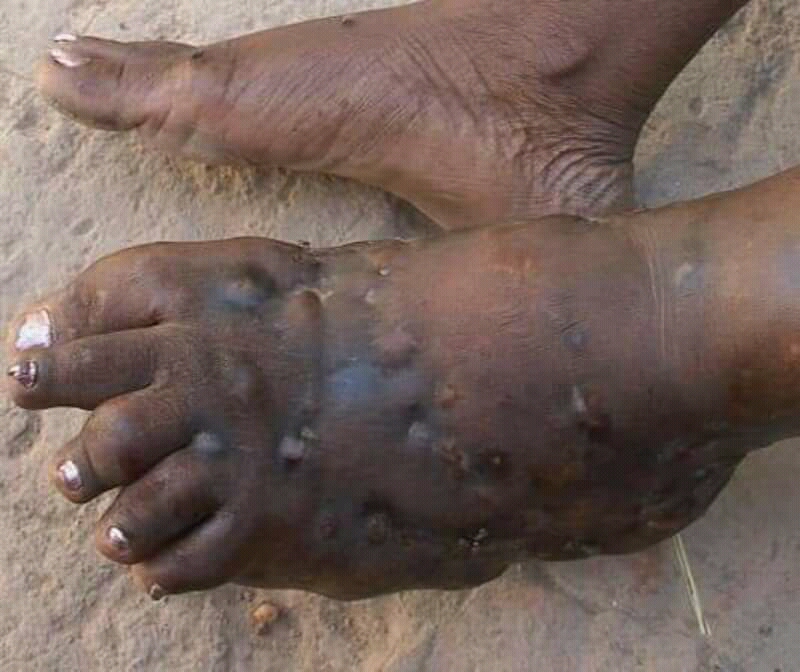|
Actinomycetoma
Actinomycetoma is a chronic bacterial subcutaneous infection caused by ''Actinomyces'' that affect the skin and connective tissue. It is, therefore, a form of actinomycosis. Mycetoma is a broad term which includes actinomycetoma and eumycetoma under it. However, eumycetoma is caused by fungal infection in contrast to actinomycetoma that is caused by bacteria mostly anaerobic. The predominant site of infection is the foot and leg. Both actinomycetoma and eumycetoma Eumycetoma, also known as Madura foot, is a persistent fungal infection of the skin and the tissues just under the skin, affecting most commonly the feet, although it can occur in hands and other body parts. It starts as a painless wet nodule ... show very similar clinical and radiological presentations. And both chronic infections are endemic in tropical countries. References {{Reflist Bacterial diseases ... [...More Info...] [...Related Items...] OR: [Wikipedia] [Google] [Baidu] |
Mycetoma
Mycetoma is a chronic infection in the skin caused by either bacteria (actinomycetoma) or fungi (eumycetoma), typically resulting in a triad of painless firm skin lumps, the formation of weeping sinuses, and a discharge that contains grains. 80% occur in feet. Most eumycetoma is caused by ''M. mycetomatis'', whereas most actinomycetoma is caused by ''N. brasiliensis'', ''S. somaliensis'', ''A. madurae'' and ''Actinomadura pelletieri''. People who develop mycetoma likely have a weakened immune system. It can take between 3 months to 50 years from time of infection to first seeking healthcare advice. Diagnosis requires ultrasound and fine needle aspiration. While most cases of mycetoma occur in Sudan, Venezuela, Mexico, and India, its true prevalence and incidence are not well-known. It appears most frequently in people living in rural areas, particularly in farmers and shepherds, who are often men between 20 and 40 years earning the primary incomes for their families. It has b ... [...More Info...] [...Related Items...] OR: [Wikipedia] [Google] [Baidu] |
Eumycetoma
Eumycetoma, also known as Madura foot, is a persistent fungal infection of the skin and the tissues just under the skin, affecting most commonly the feet, although it can occur in hands and other body parts. It starts as a painless wet nodule, which may be present for years before ulceration, swelling, grainy discharge and weeping from sinuses and fistulae, followed by bone deformity. Several fungi can cause eumycetoma, including: ''Madurella mycetomatis'', ''Madurella grisea'', '' Leptosphaeria senegalensis'', ''Curvularia lunata'', ''Scedosporium apiospermum'', '' Neotestudina rosatii'', and ''Acremonium'' and ''Fusarium'' species. Diagnosis is by biopsy, visualising the fungi under the microscope and culture. Medical imaging may reveal extent of bone involvement. Other tests include ELISA, immunodiffusion, and DNA Barcoding. Treatment includes surgical removal of affected tissue and antifungal medicines. After treatment, recurrence is common. Sometimes, amputation is ... [...More Info...] [...Related Items...] OR: [Wikipedia] [Google] [Baidu] |
Actinomyces
''Actinomyces'' is a genus of the Actinomycetia class of bacteria. They all are gram-positive. ''Actinomyces'' species are facultatively anaerobic and they grow best under anaerobic conditions. ''Actinomyces'' species may form endospores, and while individual bacteria are rod-shaped, ''Actinomyces'' colonies form fungus-like branched networks of hyphae. The aspect of these colonies initially led to the incorrect assumption that the organism was a fungus and to the name ''Actinomyces'', "ray fungus" (from Greek , ray or beam, and , fungus). ''Actinomyces'' species are ubiquitous, occurring in soil and in the microbiota of animals, including the human microbiota. They are known for the important role they play in soil ecology; they produce a number of enzymes that help degrade organic plant material, lignin, and chitin. Thus, their presence is important in the formation of compost. Certain species are commensal in the skin flora, oral flora, gut flora, and vaginal flora of human ... [...More Info...] [...Related Items...] OR: [Wikipedia] [Google] [Baidu] |
Actinomycosis
Actinomycosis is a rare infectious bacterial disease caused by ''Actinomyces'' species. The name refers to ray-like appearance of the organisms in the granules. About 70% of infections are due to either ''Actinomyces israelii'' or '' A. gerencseriae''. Infection can also be caused by '' Streptomyces somaliensis'' and '' Propionibacterium propionicus''. The condition is likely to be a polymicrobial anaerobic infection. Signs and symptoms The disease is characterised by the formation of painful abscesses in the mouth, lungs, breast, or gastrointestinal tract. Actinomycosis abscesses grow larger as the disease progresses, often over months. In severe cases, they may penetrate the surrounding bone and muscle to the skin, where they break open and leak large amounts of pus, which often contains characteristic granules filled with progeny bacteria. These granules are often called "sulfur granules" due to their yellow appearance, although they may also be white, gray or brown. Causes ... [...More Info...] [...Related Items...] OR: [Wikipedia] [Google] [Baidu] |

